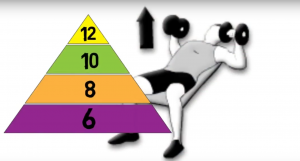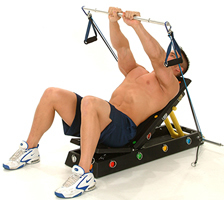A reliable method for gaining muscle strength and size is to train using an upside down–or reverse–pyramid. Reversing a typical weight training pyramid routine is one way of encouraging hypertrophy, which happens when you tear the muscle cell down by working it so that it can repair bigger and stronger. This sets your muscles up for optimal growth in size and strength.
What is a Pyramid

A true full pyramid routine takes you to the point of maxing out with heavy weights and back down again, but that takes a lot of time.
Image via Stefan Tosic/YouTube
A full pyramid routine for weight training is effective, but it is also time-consuming. And because full pyramids take up so much time, the number of different exercises that can be performed in a single workout tend to be limited. The premise is this: you begin your workout with an exercise such as bench press, performing the first set with light weight and 10 to 12 reps. Your second set is performed with slightly heavier weights and slightly fewer reps, such as 8 to 10 reps. Then your third set is performed with weight as heavy as you can press for at least 5 but no more than 8 reps. At this point, you’ve worked to the top of the pyramid and will work back down to the lightest weight and the most reps. Often people only train using the first part of the full pyramid, starting out with light weights, high reps and ending with heavy weights, fewer reps.
The Reverse Pyramid
With the upside down or reverse pyramid, you’ll only use the top-to-bottom part of the full pyramid routine. This will have you starting out with the heaviest weight you can successfully lift for at least 5 reps, moving to slightly lighter weights for the next set and finally ending with a set of light weights with more reps. Bodybuilding.com advises adjusting the weight and reps to accommodate your fitness goals. For example, using a 10, 12, 14 range of reps is supposed to help you lose fat while a range of 4, 6, 8 is supposed to do more for increasing strength.
How it Works for You
When you start out using the heaviest weights while training with a reverse pyramid, you aren’t yet fatigued from doing multiple reps with lighter weights first. All your strength and energy are available to press or lift the heavy weight. Then, as the workout progresses, the weight gets lighter–not just in your fatigued muscles’ perception, but literally. Mentally you can push yourself to work through the heavy initial set because you know it will be getting lighter as you go.
The Benefits

Any type of resistance can be used with a reverse pyramid workout, just as long as the resistance/weight can be increased to a challenging amount.
Because of the way the reverse pyramid functions, your muscles’ recovery will be more efficient. The recovery time for your muscle cells will still be the same as for any workout, about 48 hours. But because of the way your muscles are stressed with the upside down pyramid (using maximum weight at the start) the cells will rebuild bigger during the recovery. This results in gaining strength and size over a shorter period of time. You’ll also save time training because you’ll be performing fewer sets. That means you’ll be able to put more intensity into your workout and spend less time doing it.



Woowwwwww
Superb post!
This is an eye opener. I am hearing this for the first time. Will surely share the post with my friends as they all are fitness freak.
Looking forward to read many more!
Thank you for this information, Lisa!
I’ve always preferred to implement reverse pyramid, instead of starting from lower weights and gradually increasing. While I do 1-2 light sets in the beginning, I go super heavy during the next initial movements and slightly lower the weights in the next sets. This actually ensures that I lift the heaviest in the beginning, thus effectively engaging the muscle, and then pumping more blood as the weight decreases.